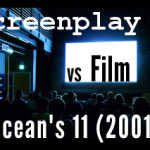Date Night made $98 million dollars at the US box office. So why is it included in Scribe Meets World’s Box Office Blues series?
The fact is, Date Night should’ve been a huge blockbuster, easily surpassing $100 million in ticket sales.
The premise–a bored married couple is mistaken for a criminal duo while out on their date night–was high-concept. The screenplay was solid. The leads were Saturday Night Live legends Steve Carell and Tina Fey. Marky Mark Wahlberg had a great supporting role. Date Night had the perfect combination of everything you’d want as a writer and producer of a movie.
But yet…it lacked something.
After watching Date Night as a movie-goer, I watched it from a screenwriter’s perspective to try to figure out what was missing–it’s not just Steve Carell’s masculinity. Let’s take a look and see what screenwriting tips you can learn from Date Night’s downfall:
Screenplay Writing Tip #1: Make your plot points special
Date Night had a perfect structure, solidly hitting all the essential plot points. This was no haphazard mash of comedy gags. But having perfectly structured three acts is not enough. Each of the essential plot points in those acts should be deep and vivid and memorable.
I’ll use the “all is lost moment” as an example. The all is lost moment in Date Night occurs after a slow-speed chase which results in a taxi cab and a very important flash drive landing at the bottom of the Hudson (uhm, it could be another body of water; geography is not my strong suit).
At this point, Claire and Phil seem the furthest away from their goal of getting the flash drive to crime lord, Miletto, which, in turn, will end their nightmarish date night and get them back to the safe suburban world they’re used to.
Sounds like this all is lost moment is pretty low. Why am I complaining?
I think the all is lost moment isn’t deep enough because I never felt that Phil and Claire’s relationship was in any danger. Despite everything they had been through, there wasn’t a question of whether or not they would stay a married couple.
That very well could’ve been the entire point. But I think the all is lost moment would have been better if Phil and Claire’s marriage seemed like it was in danger of falling apart. Then, in the climax, Claire and Phil have to repair their marriage before tackling the bad guys–together–a team made all the stronger for being wrenched apart.
You can’t be afraid to make your characters hurt; this is especially true at the “all is lost moment” before the second act break.
Screenplay Writing Tip #2: Maintain the urgency
Phil and Claire had to solve the mystery of the flash drive within one night. Such a tight deadline is screenwriting gold because it infuses a script with urgency, a surefire way to keep an audience engaged.
But an excruciatingly slow scene can cause all that urgency to evaporate (taking audience interest with it). In the middle of a frantic search for the flash drive, Phil and Claire get into a marital argument while driving. Phil complains that Claire doesn’t have that “sparkly sparkle” around him, her husband, that she had around her former real estate client, Holbrooke Grant (played by one shirtless Marky Mark).
This comment is the catalyst for a 5-minute scene, which unfortunately felt like it was 20 minutes long. A bunch of marital issues come out of the closet. Claire reveals she fantasizes about spending time alone (while Phil fantasizes about sleeping with Cyndi Lauper). The scene ends with them talking about what’s really bothering them–are they really husband and wife…or “excellent roommates” like their friends who are now getting a divorce?
The state of Phil and Claire’s marriage is an important part of the movie, equally as important as the action sequences and comic gags. The problem is that their argument slows down the action and removes all sense of urgency and momentum near the end of the second act–which is the most crucial time to keep an audience engaged.
Now if Claire and Phil’s argument had been incorporated into an action sequence, that would’ve worked. It would’ve been funny, and it wouldn’t have brought the movie’s pace to a standstill.
Of course, action movies need slow scenes too. A sustained frenetic pace can wear out an audience–but in the case of Date Night, this slow moment just didn’t work.
Screenplay Writing Tip #3: Repetition is death
In Date Night, Phil and Claire break into her old real estate firm to find Holbrooke’s phone number. After getting help from Holbrooke, in all his shirtless glory, they commit another B&E, this time trying to sneak into the home of a criminal couple who stole the flash drive in the first place.
That’s two breaking and entering scenes in the span of 16 minutes. Phil even calls attention to this repetition, saying to Claire, “You realize, of course, this is our second breaking and entering of the evening. We go through that window, we’re officially repeat offenders.”
Yeah, Phil, I noticed. And I didn’t like it.
The action in your screenplay shouldn’t be a repeat of a previous scene. That’s one reason why writing a script outline is so helpful. Script outlines make it easier to identify when your scenes are repeating themselves.
There is a circumstance where repetition works–and that’s if the second time is a bigger, more escalated version of the first. Any of the movies where the hero has to prepare for a major competition usually does this. You’ll see the characters engaged in a series of training activities, which will be showcased during the climax. But when you see these actions at the end, they are bigger, bolder…better.
This wasn’t the case with Date Night–both B&Es felt remarkably the same. Phil even left drawers pulled out, causing Claire to bump into them, in both scenes…an annoying characteristic that I’ll return to in screenplay writing tip #6.
There was another form of repetition in the movie which drove me crazy–the riff about “stealing some other person’s dinner reservation.” The two thugs sent to recover the flash drive, Detective Arroyo, and the criminal duo who stole the flash drive in the first place were all appalled to learn that Phil and Claire had taken someone else’s reservation at the fancy seafood restaurant, the decision which launched the date night from hell.
Jokes are not the same as scenes. Repetition in jokes is often a crucial part of the humor. Sometimes in a movie, a gag will repeat itself. Because of the scenes which have transpired between the first time and the second time, the second repetition has a whole new meaning, and is funnier as a result. I’d give you an example, except I can’t think of one right off the top of my head–if you can, please share in the comments!
But this wasn’t the case with the reservation joke. None of the scenes between each repetition of the reservation riff infused the joke with a deeper level of humor. The joke itself wasn’t that great to begin with, making it a bad candidate to repeat in the first place.
Maybe it’s just me, but taking another couple’s reservation at a restaurant when that couple isn’t going to show up isn’t appalling; it’s the ultra-pragmatic, Sheldon Cooper way of life.
Screenplay Writing Tip #4: the villain has to be credible
After Phil and Claire have enjoyed their luscious risotto at the fancy seafood restaurant, two thugs take them to an alley and threaten them: if Phil and Claire don’t give them the flash drive right away, they will die.
To stall, Phil claims he’s hidden the flash drive at the Central Park boathouse…so off they all go. In the boathouse, Claire pretends the flash drive is buried underneath some floor boards, and as the thugs kneel down to investigate, Phil hits them with an oar.
Success! Our heroes have gotten themselves out of a tricky situation. Isn’t overcoming an obstacle what good screenwriting is all about?
Sure…but then a few scenes later, we discover, *spoiler alert* that the two thugs are cops. Surprise!
You’re probably thinking that this is a good plot twist. Maybe. But this twist also ruins the credibility of the cops-as-thugs. Bumbling, incompetent thugs getting bested by Phil and Claire? Okay, that I can buy.
But two detectives in NEW YORK CITY, no, that strains all credibility. How in the world would two well-trained cops take their sight off of Phil and Claire for one minute at the boathouse?
Screenplay Writing Tip #5: Even minor characters need to be distinctive
To take your script to the next level, invest in your minor characters too. Each should be distinctive in some way. In Date Night, Holbrooke Grant was memorable because he was shirtless all the time (and he had very nice shoulders, as Phil was quick to point out).
But Holbrooke was basically the only supporting character who had some kind of distinctive trait. All the others came across as plot devices who existed just to move the story forward.
There was nothing unique about the babysitter, the dirty cops, Detective Arroyo and her partner, or about crime boss Miletto. They seemed like characters I had encountered in a million other movies (and TV shows). If these characters had been given a defining trait or a single-minded obsession, it would have taken Date Night to another level.
Take Bridesmaids (I’m not obsessed with this movie, I swear!). Each of the bridesmaids had a distinctive trait–Rita was the seriously over-stressed mom, Becca was the Pixar-loving innocent, and Megan was the quirky little sister who was in a class all by herself. It really says something that even though these bridesmaids had little screen time in comparison to Annie, Lillian and Helen, I can still differentiate each one.
That’s what you want for all of your supporting characters; that’s what Date Night lacked. If you want some suggestions, read this article on how to create original characters in your supporting cast.
Screenplay Writing Tip #6: Pay off all of your setups
One of Phil’s annoying habits is to open drawers, but never close them, which causes Claire to bump into them all the time.
We saw this in the first act, when Claire goes to the bathroom and hurts herself on drawers that Phil has left open. In fact, I had pegged Phil’s habit as one of the “six things that need fixing,” a concept popularized by Blake Snyder’s popular screenwriting guide, Save the Cat.
Phil repeats this habit twice in the second act–leaving drawers open at Claire’s former real estate office, and again, when they break into the apartment of the criminal duo who originally stole the flash drive. Each time, Claire knocks into the drawers. Each time, it drives her crazy.
If Phil had left open the drawers one time, I would have thought it was just an annoying trait. But he does it three times in the movie, marking his behavior as setup. I expected to see it pay off–to see it “fixed” in the third act.
It never happened, making me wonder what was the point of those scenes in the the first place?
You only have a limited amount of time to tell your story. Don’t waste that time on establishing setups that you don’t intend to pay off.
So…what do you think? Was Date Night a dud? Or I am being too harsh?
Wine Glasses by David W





















Comments on this entry are closed.
Hey SMW,
Regarding Carrell’s habit of opening drawers, I commented to a friend that I thought this would pay off in the form of an open drawer felling the bad guys in some way. I was disappointed when it was merely a character quirk by picture’s end. I thought the quirk playing a role in good guys overcoming bad would have been satisfying on its own, then to witness Carrell learning to close drawers in the epilogue would have been super-satisfying (ala one of the six things that need fixing).
Thanks for the very insight rundown on an otherwise fun movie!
Hi Kris,
Good to know someone else was bothered by the “open drawers” quirk not paying off at the end! I agree, seeing Carrell close the drawers in the epilogue would’ve been extremely satisfying…showing once again the power of the “six things that need fixing” in shaping your audience’s emotional experience.